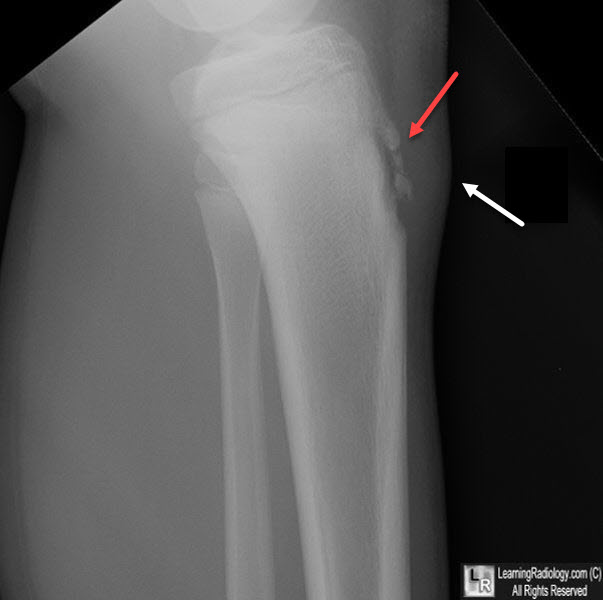|
|
Osgood-Schlatter Disease
General Considerations
- A clinical diagnosis, Osgood-Schlatter disease is a common cause of knee pain in adolescents between 10-15
- Ossification center(s) of tibial tubercle (aka tuberosity) usually fuse to each other and tibia at age 12 (girls) to 13 (boys)
- Etiology is not certain, but it involves a traction apophysitis (osteochondritis) secondary to repetitive stress injury at site of tubercle
- Contractions of quadriceps transmitted to patellar tendon produce partial avulsion of anterior surface of tibial tubercle
- May lead to heterotopic ossification at site of tibial tubercle and visible lump
- Bilateral in 25-50%; more frequent in males
- Females affected are usually slightly younger (10-11) than males (13-14)
- Occurs more often with jumping sports
- Soccer, volleyball, basketball and gymnastics
Clinical Findings
- Intermittent pain at the tibial tubercle, worsened with exercise and relieved by rest
- Edema and redness at the tubercle
- Tenderness over the tubercle
Imaging Findings
- Normal x-ray findings do not exclude the disease, which is diagnosed clinically
- Radiographs are usually obtained to exclude other causes of pain
- Conventional radiography
- Not helpful if tubercle has not calcified (usually around 9 [girls]-11 [boys] years of age)
- Best seen on lateral knee
- Irregular ossification or fragmentation of tibial tubercle
- Separated from remainder of tibial tubercle
- Soft tissue swelling
- Calcification in or thickening of the patellar tendon
- MRI
- Increased size and increased signal intensity on both T 1 and T2 of patellar tendon consistent with tendinitis
- Distension of the deep infrapatellar bursa
Differential Diagnosis
- Normal separate ossification centers
- Avulsion fractures of the tibial tubercle
- Involve entire tubercle rather than just anterior surface
- Sinding-Larsen-Johansson syndrome
- Affects inferior pole of patella
- Jumper’s knee
- Patellar (tendinitis)
- Seen in older adolescents
Treatment
- Analgesics
- Ice compresses
- Avoidance of jumping
Complications
- Painful non-union
- Union is not required, though, for relief of symptoms
Prognosis
- Months or, less commonly, years to resolve
- Self-limited

Osgood-Schlatter Disease. White arrow points to fragmentation of the tibial tubercle (tuberosity) with
overlying soft tissue swelling. There is also edema in the region of the infrapatellar bursa.
For more information, click on the link if you see this icon 
For this same photo without the annotations, click here

Osgood-Schlatter Disease. Red arrow points to fragmentation of the tibial tubercle (tuberosity) with
overlying soft tissue swelling (white arrow).
Osgood-Schlatter lesion: fracture or tendinitis? Scintigraphic, CT, and MR imaging features. Rosenberg ZS, Kawelblum M, Cheung YY, Beltran J, Lehman WB, Grant AD. Radiology. 1992 Dec;185(3):853-8.
eMedicine. Osgood-Schlatter Disease. Chang, A.
|
|
|